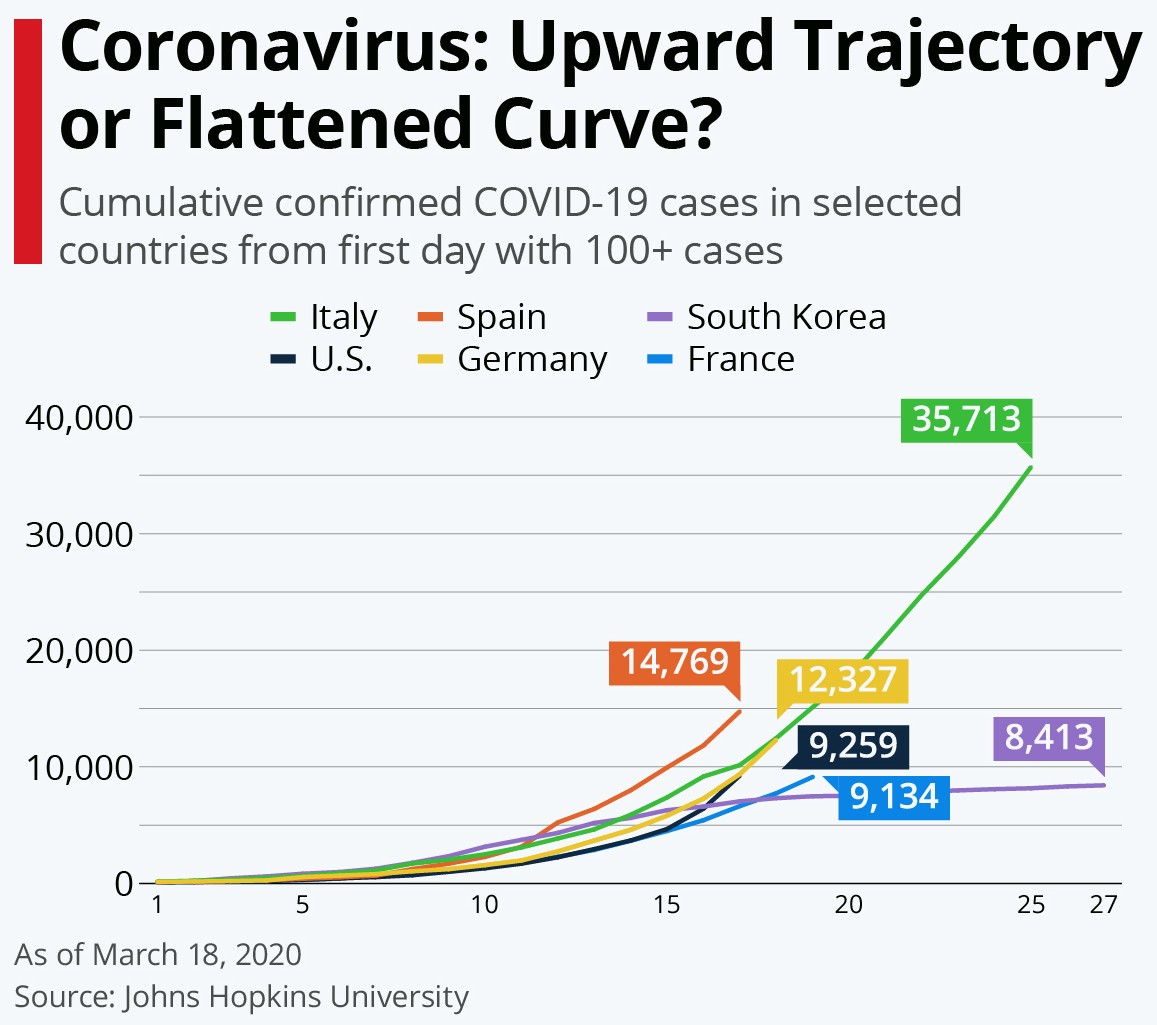
There are currently more than 250,000 confirmed cases of COVID-19 worldwide. Italy is now the hardest hit country outside of China, with more than 47,000 cases and more than 4,000 deaths as of March 20.
Epidemiologist John H. Holmes is currently a visiting professor at the University of Pavia, 20 miles south of Milan. Speaking in an online presentation from the hard-hit Lombardy region, Holmes shared his personal perspective on the ongoing pandemic. Here are Holmes’ key takeaways from the front lines of the outbreak in Europe, what the data currently tells epidemiologists, and what people can do to help combat the spread of novel coronavirus.
The disease is having a huge impact on the health care system in Northern Italy.
In one of the first towns locked down in the neighboring region of Veneto, 60-70% of patients who tested positive didn’t have any symptoms, meaning that people can carry the disease unknowingly. In Italy, people have been encouraged to quarantine themselves if they have symptoms, even before finding out their test results, because the virus is “hard to control even if you are very careful,” said Holmes.
In patients who do experience symptoms, 80% of cases are mild and flu-like, so most patients can typically rest and recover at home. But for the 1-5% of patients who experience more severe symptoms, the disease can be “devastating,” requiring intensive care beds and advanced equipment to provide them with enough oxygen. In Lombardy especially, the pandemic has overwhelmed hospitals in Pavia, Milan, and Bergamo, cities which support a network of highly sophisticated tertiary-care hospitals. Now, there are not enough intensive care beds, ventilators, medical equipment, or trained health care workers to deliver necessary patient care; 10% of the physicians are also on quarantine due to coronavirus exposure.
Data are essential for disease mitigation and resource allocation.
Holmes talked about the role of epidemic curves, which are used to track the number of cases in different regions or countries over time. These curves help researchers identify hot spots, develop mitigation or containment policies, and figure out where to allocate key health care resources.
While discussing data on Worldometers, Holmes explained that epidemiologists look not only at the total number of cases and the number of new cases but also at the ratio of recovered patients to new cases. “That gives you a good sense for how long a disease course lasts,” he said, adding that a trend showing more recovering than new cases could be a sign that the disease is being mitigated.
More data will be key in combatting COVID-19, with countries like South Korea as prime examples of successful mitigation through intense contact tracing, individual tracking, and robust testing. It will continue to be difficult for epidemiologists to estimate future trends without more data. “We don’t know the true numerator [number of people who are positive for the virus] since not everyone, symptomatic or not, has been tested,” said Holmes.
“Flattening the curve” is key, but more data, and time, are needed to get a clearer picture of what public health measures are effective.
Can national lockdowns, like the one currently happening in Italy, help “flatten the curve”? Holmes presented the current data on death rates in China’s Hubei province, which now appear to have stabilized. While the curve in Italy currently appears to be flattening, he emphasized that more data, and time, is needed to get a better sense of the trends. “I’m eager to see what happens for Italy; maybe in the coming next weeks it will be good news,” he said. “Things are quickly changing, but we don’t know how permanent those changes will be.”
Holmes also cautioned about the possibility of resurgence if social-distancing measures are relieved. “We can’t let our guard down,” he said, adding that the World Health Organization is concerned about both a summer and an autumn resurgence. “We’re in this for the long haul, and I think social distancing is here to stay for quite a while.”
Italy is taking its lockdown seriously.
The countrywide shutdown has been in place since March 10, with everything closed except food markets, pharmacies, and newsstands. Even there, the rules are very strict. For example, grocery stores are enforcing a one-meter distance rule by only letting in a certain number of people at a time and marking in tape where people should stand in line while waiting to check out.
Holmes also talked about the “auto-declaration” form: Anyone leaving home must provide details for the reason for their travel along with contact information and national ID numbers. A new clause recently enacted also requires anyone to state that they are not under doctor-ordered self-quarantine or have not tested positive for COVID-19. “They are taking this extremely seriously,” Holmes said about the local, regional, and national police who are checking paperwork and confirming information through follow-up calls and hospital inquiries. Violators are subject to lengthy prison terms.
Right now, protecting health care systems and workers is crucial.
Holmes emphasized that widespread social distancing is “absolutely critical in the U.S. right now” since the current capacity of fewer than 100,000 ICU beds is “nowhere near enough” if the disease continues to spread without mitigation. This is especially true for rural areas where hospitals often have only have a limited number of ICU beds and ventilators.
“South Korea enforced social distancing, as well as personal tracking, early and rigorously, which is something Italy should have done earlier. There should have been national social distancing three weeks ago, even four weeks ago,” said Holmes.
Now is the time to be prepared, fight disinformation, and “get political.”
Holmes’ main take-home message was to “be prepared,” and he encouraged listeners to maintain social-distancing measures.
Holmes said that anyone active on social media should push back against people’s urges to minimize the threat of the novel coronavirus while encouraging attendees to share concerns with their representatives and senators. “It’s time to get political,” he emphasized. “Public health is intrinsically a political issue.”
John H. Holmes is a professor of medical informatics in epidemiology in the Department of Biostatistics, Epidemiology, and Informatics in the Perelman School of Medicine at the University of Pennsylvania.
Additional information and resources on COVID-19 is available at https://coronavirus.upenn.edu/








